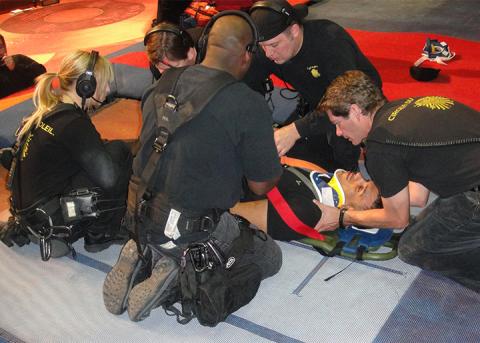
By Chris Snoddy MA, LAT, ATC
The wise phrase “Practice makes perfect" is used to convey that regular exercise of an activity or skill is the way to become proficient in it according to one internet source. How good would your sports teams be if they never practiced? How good would surgeons be if they had not practiced on cadavers earlier in their career? Athletic trainers work with coaches and orthopedic surgeons daily. Everyone realizes how much time athletes spend practicing before a game or the years of cadaver practice surgeons have before they perform surgery.
One of the most important roles of the athletic trainer is to develop, review and rehearse emergency action plans regularly. How much time do we spend actually practicing our EAPs? Emergency action plans take time to develop and even more time to practice. The best practice would be to perform an EAP at every venue on your campus or that your teams regularly use. When we have to perform it we have to actually do what we have mentally and physically practiced. The emergency action team has to practice the EAP for the best patient outcomes. "The only thing worse than not having an Emergency Action Plan might be never practicing it" said Shawn Allender, Director of Sports Medicine Outreach for STAR Physical Therapy.
The best time to practice the plan is before the season starts, when coaches are more willing to invest the time. Coaches are limited on time during the season. During the season coaches are more focused on players and plays than which one is gate C at the stadium.
Do you have an emergency action plan for both when the when the athletic trainer is there and not there? Do your coaches know what to do before EMS or the athletic trainer arrive? How is this practiced and documented?
Who on your campus has a role in the EAP? Athletic trainers, coaches, players, administrators, school resource officer and others. What is the role of the players in an EAP? If the players have seen a good EAP practice in action it makes them more accustomed to the role of everyone in the EAP. In a real emergency what happens does not seem so startling.
Points on EAP Practice:
1. Have old practice jerseys and shoulder pads that can be cut off.
2. Make some fake blood using corn syrup and red food coloring. Be sure to clean this up soon after use.
3. Use simulated fake body parts left over from Halloween?
4. Borrow your local EMS’s causality simulation or moulage kit?
How do you document EAP practice? A video of your EAP in action would be a good way to review your practices. Not only to document but also self-evaluation. A simple WWDD evaluation is a useful tool. WWDD stands for – What Worked? What would we Do Differently? Your review should be documented. After your review you may want to update your written EAP.
Finally, the quote from NATA Position Statement: Emergency Planning in Athletics by J. C. Andersen*; Ronald W. Courson†; Douglas M. Kleiner‡; Todd A. McLoda as published in the Journal of Athletic Training 2002;37(1):99–104
“Emergency plans should be reviewed and rehearsed annually, with written documentation of any modifications. The plan should identify responsibility for documentation of actions taken during the emergency, evaluation of the emergency response, institutional personnel training, and equipment maintenance.” Have a safe school year and remember “Practice makes Perfect”.





